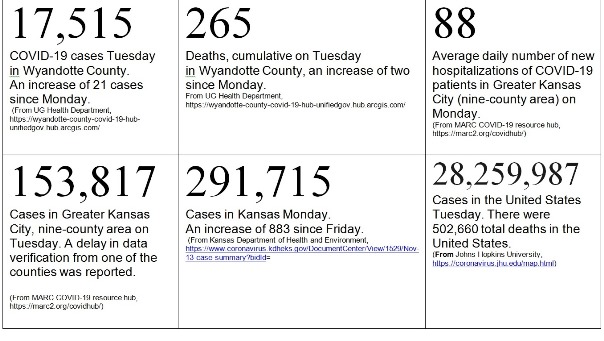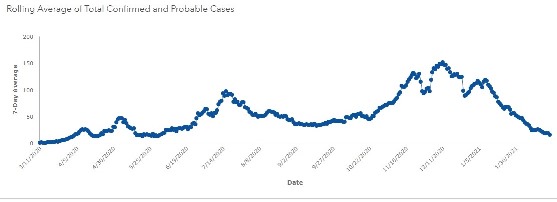

Serving Kansas City (Wyandotte County) Kansas for over 50 years!




“Is it over yet? “
Doctors at the University of Kansas Health System on Tuesday morning speculated a little bit on when it might be OK to get back to normal life, after COVID-19 recedes.
The doctors had some different ideas of when life could return to some semblance of normal.
Dr. Lee Norman, Kansas secretary of health, was a guest on the program and said it was a little over a year ago that they were talking about holding the Big 12 basketball tournament. But for this year, he thought that if the population can get to 50 to 60 percent vaccination rate, plus 12 percent who had some degree of natural immunity, they would start seeing more people gathering by the summertime.
The Kansas COVID-19 cases, hospitalizations and deaths have shown a dramatic drop over the past several weeks, according to Dr. Norman.
At what point do they relax the social distancing and mask wearing rules? He said he felt that with sunshine, Vitamin D, a mass uptake of vaccines, by the summer they should have more normalcy.
Dr. Steve Stites, chief medical officer at the KU Health System, said he would bet on the fall, as he doesn’t think there will be large scale vaccinations until June.
Because COVID-19 is starting to wane now, there might be people who take their masks off, with another surge coming out as the weather warms up and there is not enough vaccine, he said. By August things should be turning around for the better, he added.
He’s looking forward to seeing some football games at Arrowhead Stadium, and possibly some Royals baseball games.
Dr. Dana Hawkinson, medical director of infection prevention and control at KU Health System, said it could go one of two ways. If new variants start to spread, it could lead to further shutdowns or lockdowns, but he hopes it doesn’t go that way. He said he’s more optimistic that people will be able to do more things because of mild immunity, vaccinations and mask wearing.
People will nudge back toward normalcy one way or the other, even though it may not be the safest thing to do, he said.
If vaccines by Johnson and Johnson, AstraZeneca and Novavax are approved, that could greatly increase the numbers who are vaccinated.
Dr. Norman said it will require wisdom to know when policies should be loosened, and they will need to consider the social psychology as well as public policy implications. Lockdowns are probably not needed and won’t be tolerated, he said.
“But we don’t want to fling the doors open and party like it’s 1999,” he added. They need to meet somewhere in the middle, he added. It will probably be July to September when they can be safe, he said.
Until then, people need to wear their masks and socially distance, according to the doctors.
The total number of COVID-19 active and recovering COVID-19 patients at the University of Kansas Health System was 70 on Tuesday, down two from Monday, according to Dr. Dana Hawkinson, medical director of infection prevention and control. There were 33 active COVID-19 patients in the hospital, a decrease of three from Monday. Eleven of those patients were in the intensive care unit, the same as Monday. Six of those were on ventilators, the same as Monday. There were another 37 patients hospitalized because of COVID-19 who were out of the acute phase, an increase of one since Monday.
Wyandotte County reported an increase of 21 COVID-19 cases on Tuesday, Feb. 23, according to the Unified Government’s COVID-19 webpage. There were a cumulative 17,515 cases. There was a cumulative total of 265 deaths reported, an increase of two since Monday.
The Mid-America Regional Council’s COVID-19 dashboard reported 153,817 cumulative COVID-19 cases on Tuesday. The daily average of new hospitalizations was 88. MARC also reported a delay in data verification from one of the nine counties, affecting data for cases, deaths and tests, but not for hospitalizations.
The state of Kansas reported 291,715 COVID-19 cases statewide on Monday, an increase of 883 cases since Friday, according to the Kansas Department of Health and Environment. There were an additional 29 deaths reported, with a cumulative total of 4,643.
The Johns Hopkins University COVID-19 dashboard on Tuesday night reported 28,259,987 cases in the United States, with 502,660 total deaths nationwide.
The Pierson Community Center COVID-19 testing site at 831 S. 55th is open at 9 a.m. Wednesday, Feb. 24. Appointments are required, check with the website, www.gogettested.com/Kansas, for appointments.
Unified Government COVID-19 testing and vaccine sites are scheduled to be open on Wednesday. Those seeking vaccinations need to have an appointment, while those seeking COVID-19 testing may walk in and get a test kit.
The Unified Government Health Department’s COVID-19 test site at the former Kmart building at 78th and State will be open Wednesday, Feb. 24, from 9 a.m. to 3 p.m. Appointments are not needed for COVID-19 tests there on Wednesday. To see if there is any change to the schedule, visit https://www.facebook.com/UGHealthDept.
The Health Department is offering saliva COVID-19 tests to the public.
Tests from the Health Department are free for those who live or work in Wyandotte County.
The tests are open to asymptomatic people as well as those who have symptoms or have been exposed to COVID-19. Check with the UG Health Department’s Facebook page to see if there have been any changes in the schedule. Bring something that shows that you live or work in Wyandotte County, such as a utility bill.
Wyandotte County residents who are interested in getting a COVID-19 vaccine may fill out a survey form at the UG Health Department at https://us.openforms.com/Form/2f2bcc68-3b6a-450b-9007-d39819db6572. Residents will be contacted to make an appointment when vaccine becomes available. The Health Department currently is vaccinating high-contact critical workers, as well as residents over 65.
Testing sites are at https://wyandotte-county-covid-19-hub-unifiedgov.hub.arcgis.com/pages/what-to-do-if-you-think-you-have-covid-19.
Saliva testing is now offered at the UG Health Department. For more information, visit https://alpha.wycokck.org/files/assets/public/health/documents/covid/02042021-ugphd-saliva-testing-available.pdf.
The KU doctors’ news conference is online at https://www.facebook.com/kuhospital/videos/257519145849636.
The University of Kansas Health System COVID-19 update page is at https://www.kansashealthsystem.com/patient-visitor/covid19-update.
For more information about how Wyandotte County residents over 85 can get a vaccine at the Health Department site, visit https://alpha.wycokck.org/files/assets/public/health/documents/covid/02032021_wycovaccinationsage85.pdf.
Vaccine data for the state of Kansas is at https://www.kansasvaccine.gov/158/Data.
Cards and letters of encouragement for caregivers at KU Health System may be sent to Share Joy, care of Patient Relations, 4000 Cambridge St., Mailstop 1021, Kansas City, Kansas, 66160. Emails can be sent to ShareJoy@kumc.edu.
Wyandotte County is under a mandatory mask and social distancing order.
The UG COVID-19 webpage is at https://alpha.wycokck.org/Coronavirus-COVID-19-Information.
The KDHE’s COVID-19 webpage is at https://www.coronavirus.kdheks.gov/.
The KC Region COVID-19 Hub dashboard is at https://marc2.org/covidhub/.
The Wyandotte County page on the Johns Hopkins COVID-19 website is at https://bao.arcgis.com/covid-19/jhu/county/20209.html.
The Johns Hopkins Data in Motion, a presentation on critical COVID-19 data in the past 24 hours, is at https://coronavirus.jhu.edu/covid-19-daily-video.
The Kansas City, Kansas, Board of Education approved a new re-entry option for April 5 at the Tuesday night, Feb. 23, board meeting.
The board adopted a staff-recommended option for in-person school, four days a week. At this time, parents could choose either in-person school or remote learning for their children.
The district would bypass the hybrid model and move into a full in-person model for those students whose families have selected the in-person model.
Under this approved model, students would attend in-person learning on Monday, Tuesday, Thursday and Friday. On Wednesdays, there would be remote learning days. There also will be cleaning of schools on Wednesdays.
Masks will be required for all the students, teachers and staff, according to district officials. The students will have clear partitions at their desks.
At elementary schools, the Health Department has stated students could be in learning pods, according to Kristen Scott, instructional improvement officer, who presented the plans.
Dr. Alicia Miguel, acting superintendent, explained that the Unified Government Health Department has loosened some of the requirements for coming back to school. Athletes no longer need to attend all the same classes together.
She said there is some discussion going on currently around the 6-feet spacing requirement, and they are waiting for a decision from the Health Department on that, possibly later this week.
Dr. Miguel also said that about 50 percent of the students have signed up to come back in person, which will have an effect on spacing in the classrooms.
Students whose families choose remote education will livestream the classes and receive the same instruction as in-person students, according to Scott.
According to Scott, there will be a five-day window for persons who selected remote education to change their option, or for persons who selected in-person learning to change their option.
The board was asked to choose between a new hybrid option and the four-day option.
Scott said there were some drawbacks to the hybrid model of two days a week in person and three days remote attendance, including that many students have connectivity issues.
The modified hybrid model rejected on Tuesday night was that one group of students would go to the classroom in person on Mondays and Tuesdays, and another group in person on Thursdays and Fridays. The teachers would teach both groups simultaneously, as the at-home group would livestream.
Another hybrid model had been approved earlier by the board and now is being replaced by the four-day proposal.
Under the earlier hybrid model, teachers would not have taught students simultaneously, both in person and livestreaming, but these new proposals were modified so that they will teach them simultaneously.
The board voted unanimously in favor of the four-day re-entry plan.
There is an amount of uncertainty surrounding the April 5 return date, however.
The Kansas Legislature has proposed a bill, Senate Bill 235, that would mandate all public school districts return to school by March 26.
School board members asked what would happen if that bill passes. Wanda Brownlee Paige, a school board member, also asked if parents still have that other option of remote learning.
Dr. Miguel said they’re not very clear right now on how that would be enforced.
There is a lot of agreement currently on bringing kids back to school, and data has not shown that kids transmit the virus at a rate they thought they did last year, according to the superintendent. Dr. Miguel said she recommended the four-day plan because she knows three days of remote learning a week is not the best for kids.
Planning according to what they know now, parents will still have the option to choose remote learning, she said.
If the bill passes without any exemptions for remote learning, however, the board may have to push up the date for returning to school, according to officials.
Dr. Valdenia Winn, a school board member who is also a state legislator, asked how the state Legislature could kill local control of the school board.
Greg Goheen, school district attorney, said to him, local school boards have a constitutional right to operate the school districts, although the Legislature can dictate certain things as part of the legislative process. He said what the district does if the Legislature passes Senate Bill 235 will depend on the final language of the law. He said he hoped that the law, if it passes, would not treat students who are not back in school in person as truants.
“We are all in agreement if there is new legislation,” Dr. Miguel said, “we will always comply with the law and make it happen.”
If the bill does pass mandating the March 26 return date, the board may have to have another meeting to vote on another return to school plan, according to officials.
The school district brought back a group of kindergarten through fifth grade students earlier this week, on Feb. 22, because of connectivity issues. The district also brought back a select group of seniors on Monday. The board also will bring back a select group of middle school students on March 1.
In other action, the school board voted unanimously to approve a plan from Tammie Romstad, district athletic director, for the district to hold basketball substate postseason tournaments March 3 to 6.
The plan would allow two spectators per participant; currently, the UG restricts participants to 50 percent occupancy of the facility. Romstad estimated that two spectators per participant would be a crowd of 185 people. The gyms hold from 1,000 to 1,200 spectators, she added, and there would be room for social distancing.
Everyone attending would wear masks, she said.
Romstad said the plan to hold substates also depended upon whether the teams will win.
The meeting is online on YouTube at https://www.youtube.com/watch?v=7xBcb6KxV_8&feature=youtu.be.